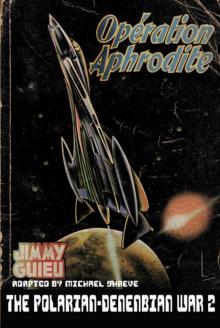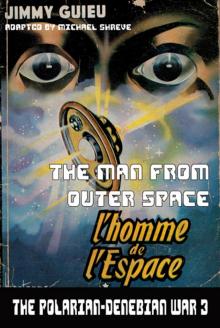- Home
- Jimmy Guieu
Polarian-Denebian War 2: Operation Aphrodite
Polarian-Denebian War 2: Operation Aphrodite Read online
The Polarian-Denebian War
(Volume 2)
Operation Aphrodite
by
Jimmy Guieu
translated by
Michael Shreve
Preface by
Richard D. Nolane
A Black Coat Press Book
There is need for the people to stay ignorant about a lot of truths and to believe in a lot of falsehoods.
-- Adapted from Montaigne
“I-just-can’t-believe-it” is all one word to highbrows and dimwits alike.
-- Robert Heinlein
The Puppet Masters
OPERATION APHRODITE
CHAPTER ONE
In spite of the early morning hour, a blazing sun shot its blinding rays on the white sand of the New Mexico desert. In the secret base of White Sands Proving Ground, the Rocketeers1 and other technicians, most of them in shorts, bare-chested and wearing safari helmets or a kind of jockey’s cap with a long bill, were dragging around their sweaty bodies. On a gigantic, cement launch pad a huge rocket, 300 feet long and 25 feet wide at the base, was standing like a metal spike.
“Good,” the general sighed, slumping back in his chair. “Let’s recommend a Test Shot without the ‘Rats and Mice’ and delay the countdown until tomorrow morning if weather conditions are favorable. Keep me up-to-date frequently.”
The chief of the White Sands base crushed out his cigarette shakily, lit another and muttered, “I’m as nervous as a new father right before the happy delivery.”
Doctor Howland smiled, tapped his pipe on the ashtray and said, “It’ll be OK, General. I have confidence in Daisy2. The countless launches of experimental rockets before Operation Aphrodite are model enough. You can also put full trust in the… Rats and Mice in our labs.”
“You can call them the team, Dr. Howland,” General Miller said. “Neither the interphone nor the transmission network is turned on.”
“These long months of secret preparation have made us too careful,” Howland admitted. “We’re so used to calling the future astronauts Rats and Mice that we end up really thinking they’re rodents.”
The three men exploded in laughter, but nervous, broken laughter. The fantastic Operation Aphrodite was not, in fact, just a simple test run of a guided missile but actually the launch of a spaceship, Daisy, to our nearest neighbor, the Moon.
General Miller absent-mindedly picked up one of the many newspaper clippings that cluttered the desk. Three years old, dated December 29, 1953.
January 1, 1962, the article revealed in substance, an interplanetary ship will leave Earth to go to the Moon. The news, as astounding as it sounds, cannot be taken as pure fantasy. It comes, in fact, from one of the preeminent figures in the world of science, Dr. Kaplan, physics professor at the University of Los Angeles, who announced it in a statement made on December 9 in Geneva before a gathering of scientists, all specialists in aerospace… The government of the USA appears very interested in Dr. Kaplan’s atomic rocket project, which it is fully supporting. A Wall Street group has raised the enormous capital needed for such a vast undertaking: four billion dollars. As of today engineers are assembled in the Pacific on the small Johnston Atoll where they are studying the construction of a launch pad3…
Many other articles dating from 1953 and 1954 announced the construction and the launch, in 1960-1965, of an artificial satellite designed by the inventor of the V2, Werner von Braun, a first before allowing, at a later date, the voyage to the Moon first and then to other planets in the solar system.
Naturally, even today, for many people these “projects” sounded more like a utopia than a rational expectation. A little more open minds, however, admitted that “someday” man would walk on the Moon, but to state even the year of departure was considered by them to be a very reckless prophecy. These newspaper articles predicting the Earth-Moon voyage for 1962, i.e. nine years later, seemed to express a greatly exaggerated optimism.
All these considerations, which came up while reading the papers, General Miller and Drs. Howland and Hutton rightfully imagined to be firmly implanted in the public mind.
Well, in 1953, when Dr. Kaplan announced the first voyage to the Moon for 1962, the Pentagon and a few specialists at White Sands already and quite rightly knew that the departure of the spaceship would take place well before this date!
The news concerning the construction project of the artificial satellite (the first phase on the road to interplanetary travel) and the preparation of Dr. Kaplan’s rocket were given to the press only to fool the public about the real date. The “average Earthling”—whether or not he believed these projects would be completed—considered them something for the far-off future.
The first stage to build an artificial satellite around 1960-1965 made it clear that man would not go to the Moon before some years after this, around 1970 according to the most optimistic estimations.4 As for the pessimists, the backward and narrow-minded, they purely and simple denied the possibility of interplanetary travel.
The reality, however, was completely different. While the man on the street was thinking, “We won’t be visiting the Lunatics, the Moon people anytime soon”, the renowned technicians of the Strategic Air Command in particular and of the Air Force in general were busy on Operation Aphrodite5, a project surrounded by secrecy comparable to the Manhattan Project which built the atomic bomb in 1945.
Extraordinary precautions had been taken since 1953 (the year in which Operation Aphrodite became reality) to keep the development and the very nature of the work top secret. At no price could they let an agent of the MVD (Russian secret police) get hold of the outlines, plans or documents that would allow the construction of Daisy, the first interplanetary rocket ship of the US Air Force.
The regrettable “leaks,” a few years earlier in the atomic centers, had to be avoided at all costs for Operation Aphrodite. And this time—the general staff was almost certain—there had been no leaks.
Daisy’s team was ready in the cabins in the middle of the night while the base, strongly guarded on a 100-mile radius, was totally deserted on the launch pad. The technicians who were now busy with the final preparations, did not know that by “Rats and Mice” the general staff meant a human team. The specialists who built the rocket, who obviously could not be kept in the dark, were confined to the secret base (somewhere in the USA) and cut off from all contact with the outside world. They could only leave in three months, whatever the outcome of Operation Aphrodite.
“Attention, T minus 25 minutes,” the speakers announced.
Lost in their thoughts, General Miller and the two laboratory chiefs jumped.
The commander in chief of White Sands looked at his stopwatch for the umpteenth time. “I wish I were three months older!” he fidgeted in his metal chair, trying to get comfortable. “We’re attempting a critical experiment for the US and maybe for world peace.”
“Attention, T minus 10 Minutes.”
General Miller pressed a button and the television wall screen turned on. The launch pad appeared with the tall, slender behemoth of super-resistant metal with one side white and the other black. The chemical coloring had been incorporated with the alloy that made up the rocket’s outer shell. There was no question of using paint to mark the two sides of the machine; the friction of the air molecules in our atmosphere on the metal would liquefy any type of paint. The contrasting colors protected the rocket, with a slight rotational spin, from solar rays in space as well as on the surface of our planet.
The last trucks and Jeeps were driving away from the massive scaffolding that giant tractors had hauled off so that the rocket could take flight. Stra
ight and rigid on its cement platform the rocket looked like it was resting between the jaws of a titan made by the two rolling blocks used as support frames until the moment of launch.
“Attention, T minus one minute.”
In the blockhouse occupied by the general and chiefs as well as in the Tracking Stations6, they no longer heard the tick tock of the electronic clocks or the heavy breathing of the observers.
“Attention, T minus 30 seconds… minus 20 seconds… minus five, four, three, two, one... IGNITION!”
On the screen a blinding corolla formed at the base of the rocket. As if it wanted to stay on the ground, it vibrated. A weird rumbling, like a low whistle, almost like thunder, filled the air. The rocket vibrated more. Slowly at first, then faster and faster, it lifted off on a huge column of scarlet flames with oranges flashes veiled by the black steam. The rumbling grew louder, soon reached its peak and became deafening—howling supersonic jets sounded like kazoos compared to the frightening din, the infernal racket that tore through the eardrums.
Little by little the column of flames lost its blinding intensity. Daisy was tilting on its axis in flight. The smoke on the ground was dissipating. Only the reddening bottom of the rocket appeared now like a burning ember mysteriously sucked into the sky.
In a few seconds the terrifying rumbling became a waning mumbling that was soon no longer audible. The blue sky, dazzling bright and clear, finally resumed its ordinary condition.
General Miller lit another cigarette, wiped his forehead and turned on the radar. The fluorescent screen lit up. The sweeping line, with every full circle, made a blip appear: Daisy, the first interplanetary rocket built by man. The blip displayed by the moving line traveled slowly away from the center of the screen.
Outside, on board the Tracking Stations, the radar men arranged their detector trucks along a line crossing the White Sands desert from east to west. Thus the rocket would be followed by radar until it reached the Moon but not only thanks to the Tracking Stations whose radius of detection was limited by the rotation of our planet. Relays had been set up.
In other parts of the USA and on board special ships and planes patrolling all over Earth, radars were given the mission to observe the trajectory of a “top secret experimental missile” transporting cameras to our satellite. All exchange of information was done in code and no press releases would be given. If by chance a foreign radar picked up the rocket, it would be very easy to make a spokesman of the ATIC7 say that for some time the radars have spotted the movements of “unidentified flying objects,” meaning a Flying Saucer! Once again the narrow minds denying the existence of these machines would gobble up the statement and straightaway put it down as an erroneous interpretation of a natural phenomenon.
General Miller turned off the radar and pulled himself wearily to his feet. “Let’s go make a toast to the Rats and Mice of good old Daisy.”
Dr. Hutton choked back a yawn. “After this all-nighter I think that’s a must!”
Daisy, the 8,500 ton rocket, after 80 seconds, had reached “escape velocity” at seven miles per second and burned almost 6,000 tons of fuel and liquid combustive: hydrazine, methanol and oxygen.
The curve of the Earth grew rapidly more pronounced until it soon revealed the roundness of the planet that filled the whole screen onboard the spaceship.
In the cockpit, Dr. Jean Kariven and the other members of the crew, lying on their anti-g sleeping seats, were slowly coming to. The takeoff had subjected them to an acceleration that quickly reached 13 g! Even with their body protected by a special, pressurized spacesuit compressing their chest and abdomen especially, they had still suffered the brutal increase in gravity. And in spite of their helmets, made of a transparent plastic material, their faces were still stretched out, their eyes still painful and their breathing hard and fast.
A click resounded in the cabin; a red light lit up on the instrument panel and the automatic pilot went to work triggering the ignition of the atomic reactors after stopping the giant pumps of the normal jet propulsion. For more than 28 hours the rocket would be powered through space by atomic energy, the liquid combustion engines held in reserve for takeoffs and landings on the Moon and Earth8.
Dr. Kariven, tall, well-built, with brown hair and a thin moustache, unfastened his straps and sat up, feeling light, very light, because of the absence of gravity in the ship now free of Earth’s pull and traveling at a steady speed. He swung slowly onto the edge of the anti-g bunk and prepared to put his feet on the floor. The big, magnetic soles of his spacesuit stuck fast to the metal floor. In space, “up” and “down” mean nothing; you could just as easily walk on the walls or ceiling!
One by one his companions, bundled up in their greenish-gray spacesuits, got up. In the pit of their stomach they again felt the awful nausea like during the dreadful acceleration. With slow and steady steps, a little awkwardly, sliding their magnetic soles over the metal floor, they gathered in the middle of the cabin and laughed as they shook hands warmly. They laughed but did not hide their intense fear. For the first time human beings had escaped Earth’s gravity and were heading to the Moon at 28,000 miles an hour.
Commander Mark Taylor of the Air Strategic Command, Professor Harrington, the celebrated physicist from Caltech9, Dr. Kurt Streiler, rocket scientist, Lieutenant Rudy Clark and Dr. Jean Kariven, anthropaleontologist and doctor on this expedition, congratulated each other.
The five friends, on account of their “service record”—hadn’t they successfully accomplished an astounding voyage into the Past?10—had been chosen by General Miller (with the agreement of the Pentagon) to make the first interplanetary flight in the history of mankind.
Daisy, the spaceship with mixed propulsion due to the prodigious work of Dr. Kaplan, had been designed by Professor Harrington and Dr. Streiler, the same ones who a few years earlier had built the Retro-timeship capable of time travel.
In addition to these five engineers and officers Daisy carried five handpicked men out of the thousand pilots in astronaut training at Randolph Field11. For the moment the five men, all with a different specialization were in a cabin next to the cockpit.
Professor Harrington was in charge of guiding the spaceship. Streiler, the young American engineer originally from Austria, was his second-in-command. Commander Taylor, the military attaché, was head of the expedition.
Harrington and Streiler got set up in the cockpit and examined the information given by all the control dials and screens on the instrument panel, which took up a large part of the circular wall of the cabin. The swiveling anti-g bunks had been folded up to become simple seats. A neon tube ran along the ceiling, lighting the cabin with a bright but not blinding light. The chrome metal walls reflected this light so harmoniously that no part of the room was in shadow. Some movable spotlights also helped so that every instrument and device in the room was clearly lit.
Above the main panel, a big screen was connected to ten periscope cameras stationed all over the surface of the rocket so that at any given time they could see outer space and the Moon from different directions.
“You can take off your helmets,” Professor Harrington declared, throwing back the transparent globe that was protecting his head. “But keep your spacesuits in. We have to be ready to get them back on in a hurry if an accident occurs in the artificial air system or… in case the hull of the ship is pierced by a meteor.”
Commander Taylor smiled with satisfaction and said, “This time, my friends, we’re not going in search of civilizations buried in the past. We’re off to conquer a dead star. In fact, Professor,” he turned to Harrington, “is there any chance we’ll encounter a life form on the Moon?”
The skeptical physicist shrugged his shoulders. “Practically none, Commander. Anyway, it would be impossible to imagine a ‘lunar’ life based like ‘terrestrial life’ on carbon. We ourselves couldn’t live on this rock without our spacesuits and Bubble Base.”
After 25 hours on the peaceful “astral road,�
�� the spaceship started slowing down. The gradual deceleration gave back to the astronauts, little by little, the feeling of weight. The closer the ship got to the lunar surface, the more difficult it got for them to move their magnetic soles.
The periscope cameras encircling the rocket sent back incredible images of the lunar surface to the screens inside the cockpit. Gnawed away by innumerable craters of all sizes, split by deep fissures and “seas” more or less connected, our satellite looked like a monstrous pale lump, grayish with shades of yellow, corroded by a mysterious, lethal pox.
Imperceptibly, as the surface seemed to “rise up” to the cameras, zones of bright green with yellow splotches appeared. From the commands of the spaceship Professor Harrington and Dr. Streiler watched the screen and the instrument panel. From time to time they pulled a lever or slowly turned a big, red, calibrated dial to correct the minute deviations in the trajectory.
With a slow and careful movement, Streiler pushed up a black handle and with his other hand flipped a switch. The nuclear reactor stopped working to bring back the landing rockets… more precisely, the moon-landing rockets. The giant pumps spit out fuel and liquid combustive that instantly flowed into the ignition system of the traditional jets.
Now only a small portion of the Moon was visible on the screen. The rocket decelerated at a constant speed toward the NNE of the satellite. To the east the huge Copernicus crater, a 55-mile diameter circle, displayed its many rays surrounded by countless crater-like formations of smaller size. To the south of this gigantic basin stood a chain of mountains in a rough S—the Montes Carpatus—whose altitude varied from around 6,500 to 13,000 feet high.
On this lifeless, airless star the shadow of these rugged mountains with ragged edges looked extraordinarily clear in the white sunlight. No semi-darkness, no half-tone, no detail blurred by elongation was perceptible on the tortured crust of the Moon. Everything here was either clearly visible or completely black.

 Polarian-Denebian War 6: Prisoners of the Past
Polarian-Denebian War 6: Prisoners of the Past Polarian-Denebian War 5: Our Ancestors From the Future
Polarian-Denebian War 5: Our Ancestors From the Future Polarian-Denebian War 4: Space Commandos
Polarian-Denebian War 4: Space Commandos Polarian-Denebian War 2: Operation Aphrodite
Polarian-Denebian War 2: Operation Aphrodite Polarian-Denebian War 3: The Man From Outer Space
Polarian-Denebian War 3: The Man From Outer Space Polarian-Denebian War 1: The Time Spiral
Polarian-Denebian War 1: The Time Spiral